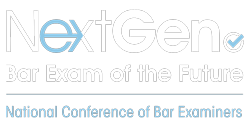MODEL A – WEIGHTED COMPENSATORY MODEL
This model includes components of the bar exam that would be scored and evaluated collectively (i.e., one pass/fail decision). The bar exam would be administered using a range of assessment methods as a single-day or multi-day event. Candidates would take the exam after law school and retest on all components if they failed to achieve a sufficient compensatory score to pass.
 |
 |
 |
|
| Structure/Components | Application of Core Doctrinal Law | Application of Lawyering Skills | Knowledge of Professional Responsibilities |
|---|---|---|---|
| Knowledge/Skills |
|
|
Professional Responsibility |
| Assessment Methods |
|
Case studies (e.g., background text, simulated clients presented via video) with legal resources; candidates review and respond via
|
|
| Decisions | One overall Bar Exam Score and Compensatory Decision
(60% Application of Doctrinal Law + 40% Application of Lawyering Skills) |
Professional Responsibility Score and Decision | |
| Administration | After law school
Event where all components of the Bar Exam are administered |
During or after law school | |
*Some panelists had concerns that these skills could not be measured objectively and without bias.
MODEL B – CONJUNCTIVE MODEL
This model includes two components of the bar exam that would be scored and evaluated separately (i.e., a separate pass/fail decision for each component). Candidates would be eligible to take the first component after completing 60 credits of law school but not required to take the first component during law school. Further, candidates would have the option to prepare for and test on each component separately, and retest on a single component, if needed.
 |
 |
 |
|
| Structure/Components | Application of Core Doctrinal Law | Application of Lawyering Skills | Knowledge of Professional Responsibilities |
| Knowledge/Skills |
|
|
Professional Responsibility |
| Assessment Methods |
|
Case studies (e.g., background text, simulated clients presented via video) with legal resources; candidates review and respond via
|
|
| Decisions | Score and Decision on the Application of Core Doctrinal Law | Score and Decision on the Application of Lawyering Skills | Professional Responsibility Score and Decision |
| Administration | Eligible to take after 60 credits have been earned in law school | After law school | During or after law school |
*Some panelists had concerns that these skills could not be measured objectively and without bias.
MODEL C – WEIGHTED HYBRID COMPENSATORY MODEL
This model includes two components of the bar exam that are scored and evaluated collectively (i.e., one overall pass/fail decision), but with a minimum performance expectation for each component. Both components will be administered after law school but not necessarily as a single event. Further, candidates would have the option to prepare for and test on each component separately and retest on a single component if needed.
 |
 |
 |
|
|
Structure/Components |
Application of Core Doctrinal Law |
Application of Lawyering Skills |
Knowledge of Professional Responsibilities |
| Knowledge/Skills |
|
|
Professional Responsibility |
| Assessment Methods |
|
Case studies (e.g., written background text, simulated clients presented via video) with legal resources; candidates review and respond via
|
|
| Decisions | One overall Bar Exam Score and Compensatory Decision with minimum performance expectations on each component (Application of Core Doctrinal Law, Application of Lawyering Skills) | Professional Responsibility Score and Decision | |
| Administration | After law school, possibly but not necessarily as a single administration event | After law school, possibly but not necessarily as a single administration event | During or after law school |
*Some panelists had concerns that these skills could not be measured objectively and without bias.


